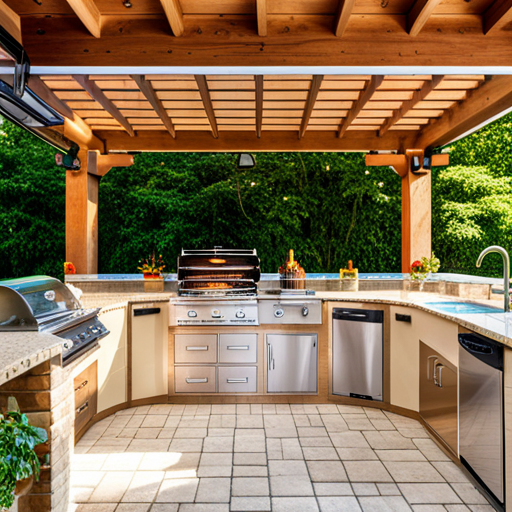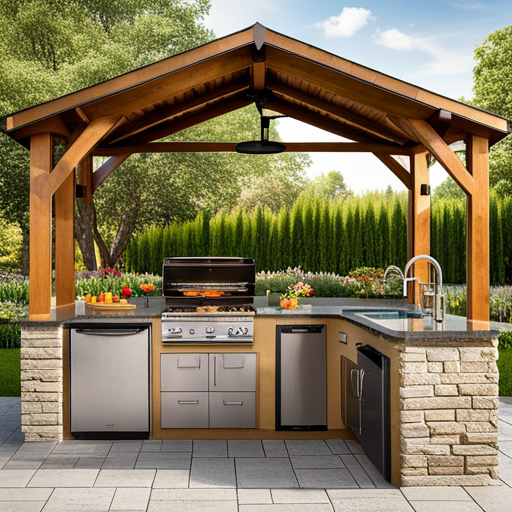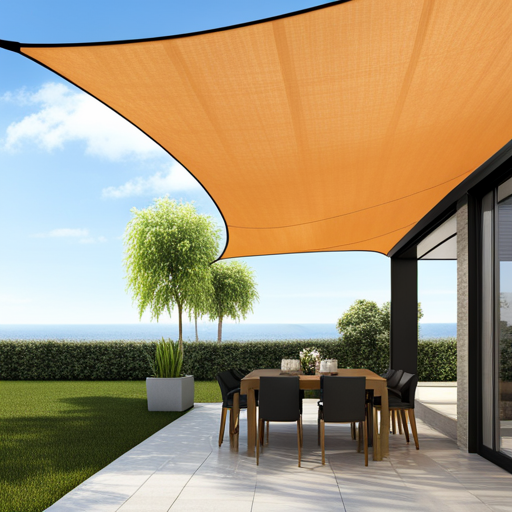Last Updated on June 26, 2024 by John Coleman
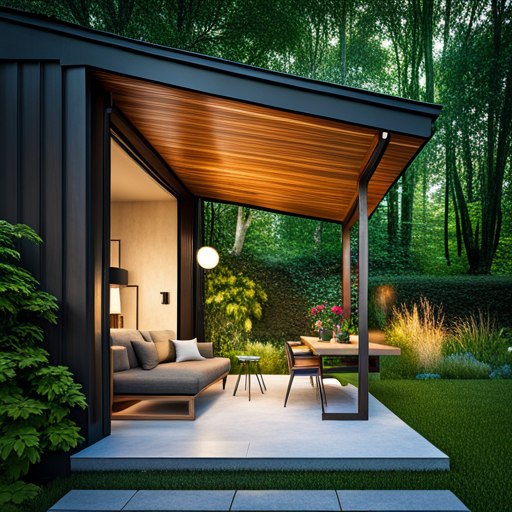
Introduction
Selecting the ideal roof extension for your patio is a crucial decision that greatly influences the usability, visual attractiveness, and value of your outdoor space. The perfect patio roof extension not only enhances the architectural design of your home but also provides essential protection against various weather conditions. With a plethora of options for extending a roof over a patio, how do you make the right choice? This comprehensive guide explores the cost, durability, maintenance, aesthetic appeal, and installation complexity, as well as the pros and cons of different roof extensions. Whether you’re a homeowner, a DIY enthusiast, or an outdoor living area designer, this guide will assist you in making an informed decision. So, let’s delve right in!
If you purchase through links on this site, we may earn a small commission. See our affiliate disclosure.
What is a Roof Extension?
A roof extension is a supplementary structure that extends beyond the edge of an existing roof, offering additional coverage and protection to a designated area. It can be attached or detached from your home, depending on your preferences and requirements. A meticulously designed roof extension should seamlessly integrate with the existing architecture while providing practical advantages like shade, shelter, and aesthetic appeal.
Benefits of Having a Roof Extension Over Your Patio
There are several benefits to having a roof extension over your patio, including:
Additional space: A roof extension can create additional living space for outdoor activities like dining, entertaining, or relaxing.
Protection from the elements: With a roof overhead, you can still enjoy your patio even in less-than-ideal weather conditions like rain, wind, or extreme heat.
Increased home value: A well-built and functional roof extension can add value to your home and make it more appealing to potential buyers. Significant to note, that in 2018, the American Institute of Architects released the results of a Design Trends Survey that indicated (according to respondents) outdoor living space was the most popular space. In the same survey, it also reported that 28% of respondents felt an outdoor living space was the most popular special function room.
Energy savings: If the roof extension is attached to your house, it can provide shade and help reduce energy costs by keeping the sun off the walls and windows of your home.
Versatility: A roof extension can be designed to match the style and aesthetic of your home, making it a seamless addition to your property.
How to Extend a Roof Over a Patio
Extending a roof over a patio involves several essential steps, including:
Design and planning: Start by evaluating the shape, size, style, and functionality of your patio. Determine the best place to attach the roof extension and its orientation to maximize natural light and ventilation.
Gather materials: Depending on your design, you will need building materials like wood or metal beams, roofing materials, and hardware.
Secure necessary permits: Check your local building codes and acquire any required permits before beginning construction.
Prepare the site: Clear the area where you plan to build the roof extension, level the ground if necessary, and mark out its boundaries.
Construct the frame: Build a sturdy frame using beams and supports that can withstand the weight of the roof and any potential weather conditions.
Install roofing materials: Cover the frame with your chosen roofing material, whether it’s shingles, tiles, or corrugated metal.
What Should Be Considered Before Building a Roof Extension
While there are many benefits to having a roof extension over your patio, there are also some important factors to consider before beginning construction. These include:
- Building codes and regulations: Before starting any construction, it’s important to check with your local government to ensure that you are following all building codes and regulations. This will help ensure the safety and legality of your roof extension.
- Materials: When choosing materials for your roof extension, consider factors like cost, durability, maintenance requirements, and energy savings. It’s also important to choose materials that will complement the existing structure of your home.
- Design and aesthetics: A roof extension should not only be functional but also visually appealing. Consider the design and style of your home when planning the look of your roof extension to create a cohesive and attractive overall appearance.
- Budget: Before beginning any construction, it’s important to have a budget in mind. This will help guide your decisions on materials, design, and other elements of the project.
- Hiring a professional: While it may be tempting to take on a roof extension project yourself, it’s important to consider hiring a professional contractor if you don’t have the skill set to support a DIY approach. A contractor will have the necessary skills and knowledge to ensure that your roof extension is built correctly and safely.
Overall, a well-built and designed roof extension can provide additional living space, increase the value of your property, and improve the overall aesthetic of your home. However, it’s important to carefully consider all aspects before beginning construction to ensure a successful project. So, it is always advisable to consult with an expert or do thorough research before making any decisions about building a roof extension on your property. This will help you avoid potential problems and ensure that your roof extension meets all necessary regulations and standards.
Main Factors In Your Final Decision Of Choosing a Roof Extension
1. Cost
The cost of a roof extension varies depending on the type, size, and materials used. Materials such as wood, aluminum, and canvas are relatively affordable compared to more luxurious options like glass or metal. Additionally, attached roof extensions tend to be more budget-friendly than detached ones because they require less labor and material. It’s essential to consider your budget and choose a roof extension that not only fits your needs but also your financial capabilities.
2. Durability
Durability is a crucial factor when it comes to choosing a roof extension. Depending on the materials used, some roof extensions can last for decades, while others may require frequent repair or replacement. For example, wood tends to be less durable than metal or glass, which can withstand harsh weather conditions and provide long-term protection. It’s essential to consider the climate and potential damage factors in your area before deciding on a roof extension material.
3. Purpose
Before selecting a roof extension, it’s crucial to determine its purpose. Do you want more shade for an outdoor living space? Do you want to enhance the aesthetic appeal of your home? Understanding the purpose of your roof extension will help you choose the right type, size, and design.
4. Compatibility
A roof extension should complement and match the existing architecture of your home. It’s essential to consider factors such as color, material, and style to ensure that the roof extension fits in with your home’s overall look. For example, a modern glass roof extension may not suit a traditional-style house, while a wooden pergola can add charm to a rustic home.
5. Maintenance
Like any other part of your home, a roof extension requires regular maintenance to keep it in good condition. Different materials may have varying maintenance requirements, so it’s essential to consider this before making a decision. For example, metal roofs may need occasional painting or rust prevention treatment, while wood requires staining or sealing to protect against weather damage.
6. Local Regulations
Before building a roof extension, it’s crucial to check with your local authorities for any regulations or permits required. Some areas may have specific guidelines on the size, height, or materials used for roof extensions. It’s important to comply with these regulations to avoid any legal issues in the future.
Common Types of Roof Extensions/Extended Patio Covers
Pitched Roof Extension (Gable Roof, Hip Roof, etc.)
A pitched roof extension is one of the most popular roof extension styles thanks to its classic design.
Cost: Medium to high, depending on material and complexity
Durability: Highly durable, especially when constructed using quality materials
Maintenance: Moderate, requires regular inspection for potential damage
Aesthetic Appeal: High, adds a traditional, timeless look to your patio
Installation Complexity: High, requires a skilled contractor or a highly skilled DIYer
Average Cost: $14,000 – $31,000
Pros: Excellent water and snow runoff; more space for ventilation
Cons: High wind susceptibility; potential for water leaks if improperly installed
(Here is the link to my in-depth article about pitched roof extensions for a patio)
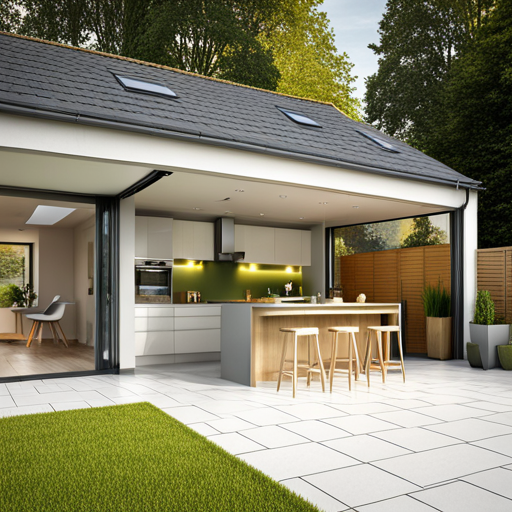
Flat Roof Extension
Flat roofs are a modern and sleek option for roof extensions, making them popular with contemporary homes.
- Cost: Low to medium, depending on material and complexity
- Durability: Moderate, may require more frequent repairs due to potential pooling of water
- Maintenance: Low, requires regular debris removal and inspection for damage
- Aesthetic Appeal: High, adds a modern and minimalist touch to your patio
- Installation Complexity: Low to medium, can be done by a skilled contractor or as an average to skilled DIY project
- Average Cost: $4,000 – $14,400
- Pros: Easy installation; provides additional outdoor living space on top of the roof
- Cons: Potential for water pooling and leaks if not properly maintained; may have limited ventilation options.
In addition to the aesthetic appeal and added outdoor space, flat roofs also offer unique design opportunities such as rooftop gardens or even solar panel installation.
When it comes to installation complexity, a flat roof can be a good option for those looking to take on a DIY project, but hiring a skilled contractor is always recommended for the best results.
Overall, a flat roof extension can be an affordable and stylish addition to your patio, with the added bonus of potential design opportunities and increased outdoor living space. If you would like more information, here is another article that specifically discusses flat roof extensions.
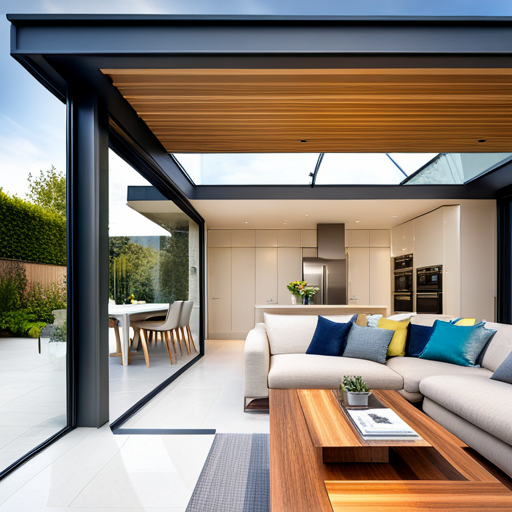
Pergola Roof Extension
A pergola is an open-roofed framework over your patio, often adorned with climbing plants. This type of roof extension is a popular choice for those looking for an elegant and natural addition to their outdoor space.
- Cost: Low to medium, depending on material and size
- Durability: Moderate, depending on the material used and exposure to weather elements
- Maintenance: Low to medium, requires regular cleaning and plant pruning
- Aesthetic Appeal: High, adds a natural, garden-like feel to your patio
- Installation Complexity: Low to medium, a good project for skilled DIY enthusiasts
- Average Cost: $1,500 – $12,000
- Pros: Affordable; customizable; allows for climbing plants
- Cons: Limited weather protection; requires regular upkeep for plants
(If you would like more detailed information, see my post about pergolas.)
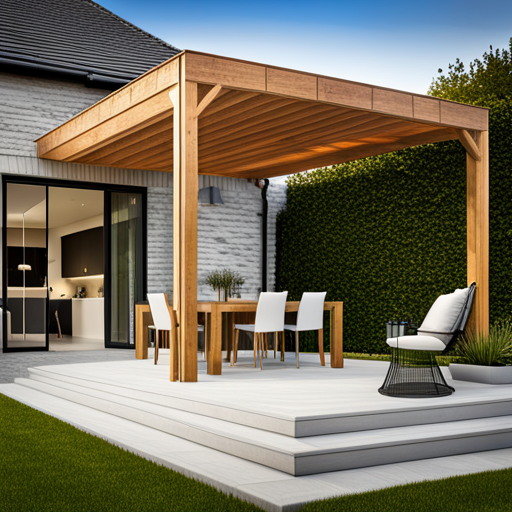
Lean-To Roof Extension
A lean-to-roof extension is a simple and cost-effective option for extending your patio’s coverage. It consists of a slanted roof attached to the side of your home, protecting it from rain and sun. Below are highlights of lean-to roof extensions but here is the link to a detailed article I wrote about lean-to roof extensions for a patio.
- Cost: Low, due to simple design and fewer materials needed
- Durability: Medium, may not withstand heavy snow or wind loads as well as other options
- Maintenance: Low, may require occasional cleaning and minor repairs
- Aesthetic Appeal: Medium, limited design options compared to other roof extensions
- Installation Complexity: Low, can be a DIY project with some construction knowledge or can be installed by professionals
- Average Cost: $1,000 – $4,500
- Pros: Low cost and simple design; can easily be attached to an existing structure; provides shade and protection from rain
- Cons: Limited design options; may not withstand harsh weather as well as other options.
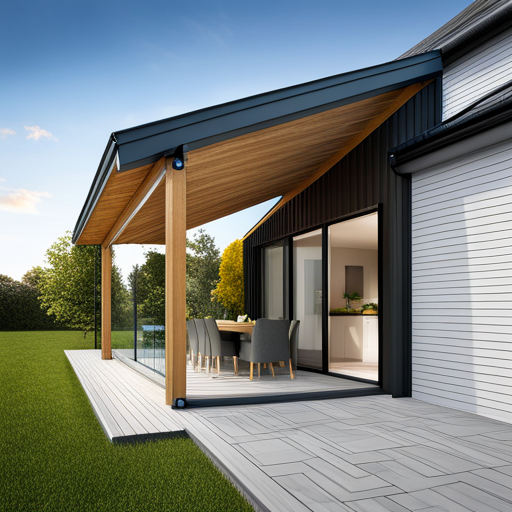
Louvered Roof Extension
A louvered roof is an adjustable patio cover that can be opened and closed to control the amount of sunlight and shade.
- Cost: High, due to its advanced technology and materials
- Durability: Highly durable, resistant to extreme weather conditions
- Maintenance: Low, easy to clean with regular maintenance
- Aesthetic Appeal: High, modern, and sleek design
- Installation Complexity: High, requires professional installation
- Average Cost: $4,320 – $20,700
- Pros: Adjustable sunlight and shade control; highly durable; low maintenance
- Cons: Expensive initial cost; complex to install; limited design options compared to other extensions.
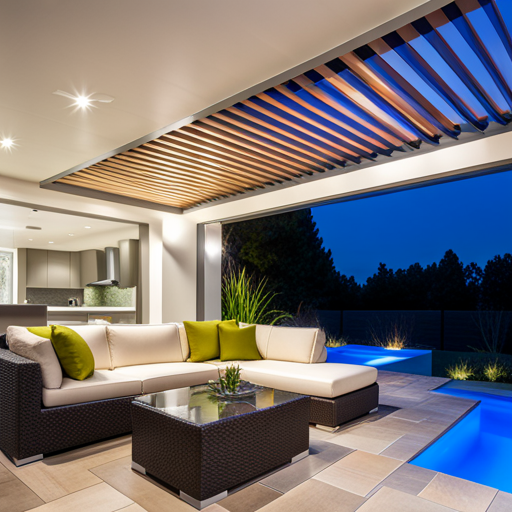
Retractable Awning Roof Extension
A retractable awning is a shade structure that can be extended or retracted as needed, providing flexibility and convenience.
- Cost: Medium to high, depending on size and features like motorized operation
- Durability: High, made with durable materials such as aluminum and waterproof fabric
- Maintenance: Low, occasional cleaning and upkeep of mechanical components
- Aesthetic Appeal: Medium, can look bulky when retracted but offers a modern and sleek design when open
- Installation Complexity: High, requires professional installation for proper operation
- Average Cost: $1,025 – $4,750 (Typical price range) Price will depend on whether you choose a manual vs. a motorized model.
- Cons: More expensive than other options; requires professional installation; limited design options for open awning

Sun Shade Sail
A sun shade sail is a modern and stylish option for shading your patio, with a wide range of colors and shapes available.
- Cost: Low to medium, depending on size and material used
- Durability: High, made with UV-resistant fabric and sturdy support structures
- Maintenance: Low, occasional cleaning and re-tensioning if needed
- Aesthetic Appeal: High, offers a contemporary and unique design element to your outdoor space
- Installation Complexity: Medium, can be installed by a skilled DIY enthusiast but may require professional assistance for larger or more complex installations
- Average Cost: $300 – $800 (for a standard 12×12 ft sail)
- Pros: Affordable option with customizable shape and color choices; provides shade and UV protection; easy to maintain
- Cons: Requires proper installation for stability and functionality; limited coverage area compared to other options.
Here is How to Install a Sunshade Sail
If you are considering a standard or custom sunshade sail, check out Covers & all. They make it easy. You pick a shape and fabric color and enter your measurements. They will make it to your specifications and ship it to you.

Types of Patio Roofing Materials
There are several materials to choose from when constructing a patio roof. Here are some popular options and their benefits:
- Aluminum: Affordable, lightweight, low maintenance, and durable against harsh weather conditions.
- Polycarbonate: Lightweight, affordable, and provides UV protection; however, may not be as sturdy or long-lasting as other materials.
- Canvas: Provides a softer look and can be easily removed or replaced; not as durable as other materials and may require more maintenance.
- Fiberglass: Lightweight, affordable, and provides UV protection; however, may not be as durable against harsh weather conditions.
- Metal: Durable and long-lasting with low maintenance requirements; can be prone to rusting if not properly treated.
- Wood: Customizable and aesthetically pleasing, but requires regular maintenance to prevent rotting or warping.
Each material has its own unique qualities and it’s important to consider your budget, desired aesthetic, and maintenance preferences when choosing the right material for your patio roof.
Regular Maintenance Is Key
No matter what material you choose for your patio roof, regular maintenance is necessary to ensure its longevity. This includes regularly checking for any damage or wear and tear, cleaning off debris and dirt, and treating the material as needed.
Additionally, it’s important to keep an eye out for any signs of potential issues such as leaks or weak spots in the structure. Catching these problems early on can save you from costly repairs down the line.
If you’re unsure about how to properly maintain your patio roof, consult with a professional or do some research to learn the best practices for your specific material. With regular maintenance, you can enjoy your patio roof for years to come
Adding Personal Touches
Once you’ve chosen and constructed your patio roof, it’s time to add some personal touches. Consider incorporating decorative elements such as string lights, potted plants, or outdoor furniture to make your patio area more inviting and comfortable.
You can also consider adding features like a built-in fireplace or outdoor kitchen to elevate the functionality of your patio. Get creative and think about how you can make the space truly your own.
Conclusion
Choosing the right roof extension for your patio is a crucial decision that involves a careful evaluation of various factors such as cost, durability, maintenance, aesthetic appeal, and installation complexity. This guide provides a comprehensive analysis of the most popular roof extension types to help you make an informed choice. Remember, the best roof extension for your patio is one that meets your specific needs, preferences, and budget while adding value to your home.
For more insightful articles on DIY outdoor living, don’t forget to check out my other posts:
Outdoor Patio Gazebos: The Best Design Guide With Images of Gazebos
A Guide to Design a Low-Budget DIY Outdoor Kitchen
Frequently Asked Questions
What is the best material for a patio roof extension?
There is no one definitive answer to this question as the best material will depend on your specific needs and preferences. Some popular options include metal, wood, and polycarbonate.
How much does it cost to build a patio roof extension?
The cost of building a patio roof extension can vary greatly depending on the materials used, the size of the patio, and labor costs. On average, you can expect to spend anywhere from $3,000 to $10,000 for a basic roof extension.
Do I need a permit to build a patio roof extension?
It’s important to check with your local building codes and regulations before starting any construction on your patio. In most cases, you will need a permit for any structural changes or additions to your home, including a patio roof extension.
Can I install a patio roof extension myself?
While it is possible to install a patio roof extension yourself, it’s recommended to hire a professional contractor for the job. This ensures that the installation is done correctly and safely, and can also save you time and potential headaches.
How long does it take to build a patio roof extension?
The timeline for building a patio roof extension can vary depending on factors such as the size of the patio and materials used. However, on average, it can take anywhere from 1-2 weeks for construction and installation.
Will adding a patio roof extension increase the value of my home?
Yes, a well-built and functional patio roof extension can increase the value of your home. It adds an additional living space that can be used for entertaining or relaxing, making it appealing to potential buyers. However, it’s important to consider the cost of building the extension in relation to the potential increase in property value before making any decisions.
If you purchase through links on this site, we may earn a small commission. See our affiliate disclosure.


